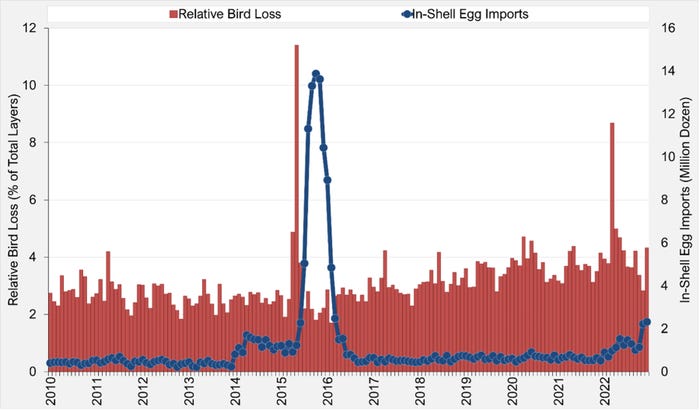
In 2022, U.S. consumers faced persistently high egg prices, where egg prices increased significantly more than food prices overall.
According to the Bureau of Labor Statistics, the average retail price of eggs (grade A, not seasonally adjusted) reached a record high of $4.25/dozen in December 2022, up 138% from December 2021 ($1.79/dozen).
The reasons given for this surge included supply-chain disruptions due to the COVID-19 pandemic, increased egg demand during the holiday season, and overall inflation, but most articles cited highly pathogenic avian influenza (i.e., bird flu) outbreaks and resulting bird loss as the primary cause.
In a recent article in Choices, I proposed that higher production costs along with the negative consequences of bird flu sufficiently explained the rise in egg prices.
Similar losses
The reason why I was not completely sold on bird flu as the sole or even primary cause is that the U.S. experienced similar and even larger losses in the egg laying population due to bird flu in 2015, yet egg prices did not increase as much as they did in 2022.
To be certain, egg prices did increase in 2015, peaking at $2.97/dozen, but this increase was still significantly less than what was experienced last year.
What many failed to discuss — including me — is the role that imports might have played in mitigating the effects of negative production shocks due to substantial declines in the U.S. egg-laying population.
Figure 1. Relative Bird Loss and In-Shelled Egg Imports in the United States: January 2010 – December 2022

University of Tennessee Institute of Agriculture
Figure 1 shows relative bird loss, expressed as a percent of the total table-egg laying population, and the quantity of in-shell egg imports (million dozen) from January 2010 to December 2022.
Population range
The U.S. table egg laying population ranged from 283 million birds in 2010 to a high of 337 million birds in 2019, and monthly bird losses between 2% and 4% appear to be the price of doing business.
In 2015, however, bird losses peaked at 11% due to bird flu. In the months that immediately followed, in-shell egg imports reached record levels, increasing to nearly 14 million dozen in October 2015, which is more than a 2,000% increase when compared to average monthly imports prior and in the months that followed (less than one million dozen on average).
Imports did not significantly increase again until 2022 when bird losses peaked at around 9% in 2022 and exceeded 4% in the months that followed. Unlike 2015, however, the response in in-shelled egg imports was marginal by comparison, increasing to only 2 million dozen in late 2022.
The reasons for the significantly larger import response in 2015 versus 2022 is a subject for another time. But what is clear is that the surge in imports in 2015 and the relatively modest import increase in 2020 could be a reason why egg prices increased more so in 2022.
Source: Southern Ag Today
About the Author(s)
You May Also Like




